By Leonard Chan
This is the fourth edition of our year-end review of children’s picture books we featured in our newsletters during the course of the year.
If you wish to read our guidelines, you can read them on our favorite children’s picture book guidelines page.
This year, I was able to read 66 of the 72 books that were accessible to me. Even though I read a sizable number of the books during the course of the year, it’s interesting when you have all of these books together and get the chance to compare them. A good majority of these books were nearly equal in my current rating system, which made it tough for me to pick my favorites.
As you may imagine, many of the books were quite different from each other. A good portion of the books were culturally related. Others were about people or some historical event or time. Some were life affirming and or inspiring. Many of the books were educational, informative, or made you think or imagine. A few were silly, cute, or even sad. The better books often had more than one attribute.
Most of my favorites moved me in some way, but this exercise is really quite subjective and can vary a lot depending on your mood or mindset at the time you read the book. Even so, I find the experience quite enlightening and useful, and it helps us better serve you all.
Most of what I’ve just written can be stated over and over again, every time I write another installment of this series. So excuse me in future years when I ask you to just go back and read this introduction again.
Okay, like last year, I’ve divided my favorites into two groups: the first group of books will be original stories and the second will be books based on real people and or events.
Original Stories
More Information
Or to Order
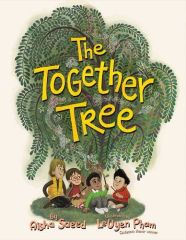
(Number 4)
The Together Tree
By Aisha Saeed (Author), Leuyen Pham (Illustrator)
This is essentially a new-kid-in-class story. There were a couple of similar books this year. The other notable ones were immigrant stories. “The Together Tree” is about a child that has moved from San Francisco to another part of the country. So I guess it is kind of a drastic move :). The new kid is taunted and bullied for being different and quiet.
What made this book stand out was the portrayal of one of the other students that stood by, observed what was going on, started to empathize, and ultimately took action when things had gone a little too far. Eventually all the fellow classmates are won over once they really get to know the new kid.
This is a simple story that has been told many times before, but empathy and the drive to learn about others are things that we should always strive for – in a children’s book this can be quite powerful.
(For More Information or to Order)
More Information
Or to Order
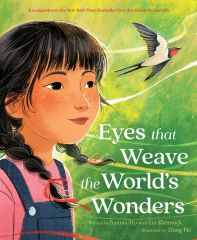
(Number 3)
Eyes that Weave the World’s Wonders
By Joanna Ho (Author), Liz Kleinrock (Author), Dung Ho (Illustrator)
This is a story about a Korean girl adopted by Caucasian Americans.
With all of the usual questions and thoughts about looking different and wondering about her birth mother, the girl’s story is told quite lyrically in beautiful words and illustrations.
Perhaps the most profound thing about the books is the co-author’s (Liz SoHyeon Kleinrock) note at the beginning which makes clear that the story’s depiction is only one story of an adoptee and her parents. “There is no one-size-fits-all story when it comes to adoption. Every adoptee’s experience is unique.” Kleinrock goes on to say that for adoptive parents, “I hope this book becomes an access point for you to engage with your child about their experience.” And for the adoptees reading the book, Kleinrock says, “your feelings are valid, whatever they may be. You are the expert in your experience. You are not alone.”
Many of the books I’ve read for this article have very interesting author’s notes and oftentimes, the notes complete the story.
(For More Information or to Order)
More Information
Or to Order
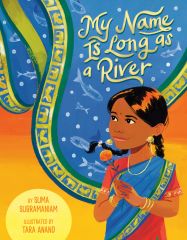
(Number 2)
My Name Is Long as a River
By Suma Subramaniam (Author), Tara Anand (Illustrator)
Over 23 years ago, Yangsook Choi wrote her wonderful children’s book “The Name Jar.” Since that time, a common theme for children’s books, especially for the ones that we carry, has been issues concerning names. Perhaps almost as much as how we look and probably even before our culture, our names are one of the things that help to differentiate and define who we are. After all, our names are one of the first things people learn about us.
In “My Name Is Long as a River” a girl named Kaveri Thanjavur Jayalakshmi Ganesan learns the true meaning of her name as she takes a family trip to her ancestral home in India. As we learn each part of her name, we discover something about Indian geography (the river that she is named after and the city that she was born in), a goddess that she and her mother are both named after, and her family’s name which is also derived from a god’s name. As we learn the beauty of Kaveri’s name we learn a little about India and its culture.
The wonderful illustrations of the Kaveri river as it flows into the ocean and Kaveri and her grandmother watching really adds so much to the end of the story.
As Kaveri and her grandmother watch the Kaveri River brilliantly flow into the ocean, Kaveri says “I belong to it, and it belongs to me.”
The endnotes include a section with instructions on how to proudly state your name and how you can learn to say someone else’s name correctly. Another endnote section includes a map and some information on the Kaveri River.
Lastly, the endnotes conclude with classic poems and sayings about the Kaveri River.
(For More Information or to Order)
More Information
Or to Order

(Number 1)
My Grandfather’s Song
By Phùng Nguyên Quang, Huynh Kim Liên
“My Grandfather’s Song” is about a grandfather teaching his grandson to be one with nature. As early settlers to this part of Vietnam, the animals and the sounds of nature are ever-present. In one scene during a storm, the grandfather calms the grandson down by saying, “You do not have to shout down the storm. Find its rhythm; sing with it,” and then he proceeds to sing his grandson to sleep.
As time passes, the grandson learns the grandfather’s ways and songs of nature. Eventually others move to the land, and towns and communities grow.
Even though we can’t physically hear the songs of the grandfather and the sounds of nature, the text and illustrations are a lyrical song that we can imagine hearing.
Although this book is about Vietnam, it could really be about any pioneering family to a wild land.
The authors’ endnotes express their desire for the readers to be respectful and thankful of nature and the Earth. These are good sentiments that I also wish will take root with the readers.
(For More Information or to Order)
Original Stories Honorable Mention
• Love Grows Here - a girl discovers that the best way to combat hate is with love and acts of kindness.
• Simone - a girl learns to persevere in the face of hardships, the value of community, and how to use creativity to survive.
• The Yellow Áo Dài - when a girl learns of the story behind her mother's dress, reader will recognize that their family's stories matter too.
.
.
Nonfiction Favorites
More Information
Or to Order
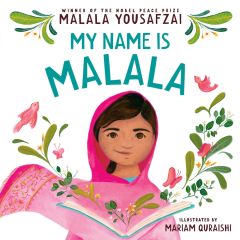
(Number 4)
My Name is Malala (board book edition)
By Malala Yousafzai (Author), Mariam Quraishi (Illustrator)
One of the criticisms I have with some children’s books is the inappropriateness (age wise) for some books. Oftentimes, I read books that are in a picture book format that really seem more appropriate for older kids or maybe even teens. I imagine that it’s hard for these authors and book creators to truly view their creation through the eyes of the little kids. I think I sometimes have this problem too when I recommend books to some parents for their little kids. This is especially difficult when I see an interesting book (at least to me) about some person that I think all people, including children, should really get to know.
There are a number of books written about Malala Yousafzai, the Nobel Peace Prize winning activist, including several written by her. This one, which is in a board book format (a format usually intended for young kids), is appropriately written for this age group.
In this book, a young child will see someone that may look a little like them. Malala has family and friends and reads books just like them, but she comes from a faraway place called Pakistan.
The young reader will also learn that Malala is a writer and activist, who fights to make sure all girls can get an education.
This book is really simple, but in its wonderful brief way, it imparts to young kids that they can someday make a difference too.
(For More Information or to Order)
More Information
Or to Order

(Number 3)
The Bridges that Yuri Built: How Yuri Kochiyama Marched Across Movements
By Kai Naima Williams (Author), Anastasia Magloire Williams (Illustrator)
Ah, another book about an activist. Are you starting to see a pattern here :)?
When it comes to non-fiction children’s books, a lot of them are about good people that make great role models for kids. At the very least, these books tell interesting stories about people that deserve to be better known. This is definitely the case with “The Bridges that Yuri Built.”
Yuri Kochiyama is such an interesting activist, that there were actually two books about her that we featured with our newsletter. The other one, Yuri Kochiyama by Karen Su, was also a good book, but this one was a little more in-depth and was written by Yuri Kochiyama’s great granddaughter.
What made Yuri Kochiyama’s activism commendable was that she helped people that were not necessarily part of her “in-group” (people you closely identify with; read our article from 2007). Her work bridged communities.
(For More Information or to Order)
More Information
Or to Order

(Number 2)
The Rock in My Throat
By Kao Kalia Yang (Author) Jiemei Lin (Illustrator)
Up till this very moment, I was debating whether to rank this book in my list of favorites or just include it as an honorable mention. The reasons for this are that the book may not appeal to a lot of readers, it’s not inspirational, and it ends rather abruptly. Even though the writing and illustrations were first-rate for the story part of the book, if it were not for the author’s endnotes, this book would not have made my list of favorites.
Back in 2021, Kao Kalia Yang was the author for two of my favorite children’s books for that year (“Yang Warriors” and “The Most Beautiful Thing”). Thus it was surprising to learn that “The Rock in My Throat” is about Kao Kalia Yang’s seemingly unexplainable mutism in English. From halfway between first and second grade until she went to college, Kao Kalia Yang did not speak in school, but even more inexplicably, spoke at home.
Throughout this book, I was struggling to understand why Kao Kailia Yang couldn’t talk – what was her problem? In conclusion, I came to the realization that perhaps the fault didn’t lay completely with Yang. The sometimes cruel English speaking world that she found herself in, after she had migrated to the US from a refugee camp in Thailand, was partially to be blamed.
Kao Kalia Yang’s mysterious silence may especially be hard for kids to understand, but the book’s ultimate message may be one of empathy. Yang in her endnotes states, “I’m thankful that I know to be patient when others are struggling into language. I understand what it is like to be lonely and, in the end, to love and appreciate the people who offer friendship.”
(For More Information or to Order)
More Information
Or to Order
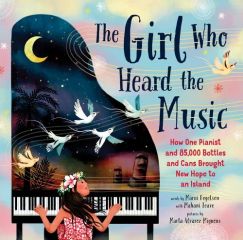
(Number 1)
The Girl Who Heard the Music: How One Pianist and 85,000 Bottles and Cans Brought New Hope to an Island
By Mahani Teave (Author), Marni Fogelson (Author), Marta Álvarez Miguéns (Illustrator)
Before I read this wonderful book, I was feeling a bit blue. I started reading it and by the end I wanted to learn more about Mahani Teave, the pianist that the book is about. I found a short National Public Radio concert video online and played it. Something about this book and her playing really moved me, and reminded me that there were good things in life.
Not long ago, we were at the National Pacific Islander Education Network conference and someone took a quick look at this book, but I could not adequately explain it to her. If I had a second chance, I would tell her how wonderful it is and how Mahani Teave’s story was truly inspirational.
Mahani Teave, the daughter of a Caucasian American mother and a native of Rapa Nui (Easter Island) father, was born in Hawaii, but raised in her father’s homeland. On a remote island with less than eight thousand people, there was very little exposure to Western classical music for Mahani. The entire island of Rapa Nui didn’t even have a piano until Mahani was nine-years-old and a retired music teacher brought one with her to the island. Having first seen a piano being played in the States by her grandfather, Mehani was eager to learn how to play. First with lessons from this retired music teacher and then continuing on with intense instruction in Chile, America, and Germany, Mahani eventually became a renowned traveling concert pianist.
What makes Mahani's story more touching is that she gave up dedicated touring and returned to Rapa Nui to live and to start a free music school for the children of the island. Her nonprofit school (NGO Toki) needed a permanent building. So they decided to build one, but not just any building; they made it out of recycled garbage because it was the most plentiful material available, and they wanted to set a good ecological example. The school also includes an eco-friendly farm where they hope to help make Rapa Nui more self-sustainable.
“The Girl Who Heard the Music” includes wonderful endnotes with facts about Rapa Nui, information on the Moai statues, a short Rapanui glossary, information about the school’s earthship design, and information about Rapa Nui’s dire ecological situation.
You can watch a documentary called “Song of Rapa Nui” which tell Mahani Teave’s full story and you can buy her album “Rapa Nui Odyssey” which helps to fund her nonprofit organization (Amazon, Spotify, Apple Music).
(For More Information or to Order)
Copyright © 2024 by AACP, Inc.







